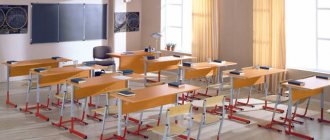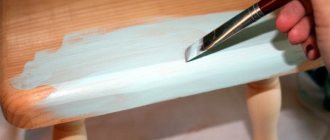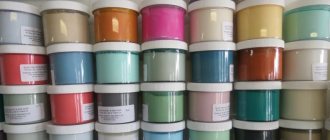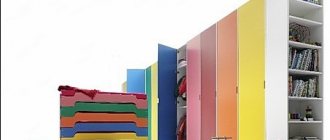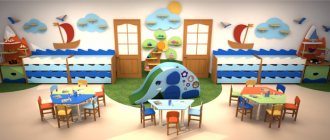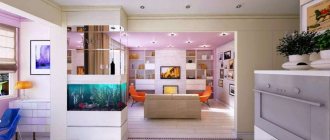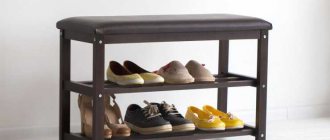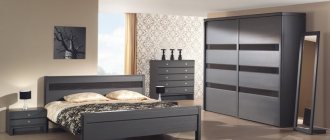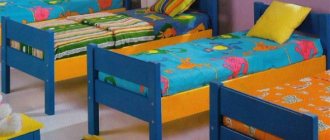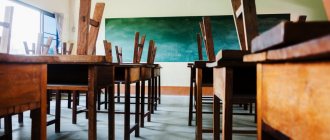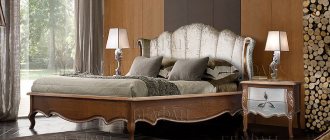School furniture
is the main element in organizing the educational process. To make the learning process more effective, it must be convenient, safe and multifunctional. The production of school furniture should involve the use of modern technologies and equipment that meets all the best international requirements. This is a high-tech and knowledge-intensive process. Recently, in order to increase the effectiveness of learning, it is simply necessary to select school furniture correctly and competently.
After all, the health of the child, the correctness of his posture and the general condition of the spine depend on this. After all, it is the spine that suffers from uncomfortable posture and excessive stress. It is extremely important that children sit on comfortable chairs, at wide, comfortable desks where all textbooks and notebooks can be placed. After all, if the child is comfortable, then he will not be distracted from the educational process.
Types of school furniture
Each classroom must be equipped in accordance with SanPiN standards. A standard set of furniture in a classroom or student auditorium includes:
- desks;
- chairs;
- teacher's desk;
- cabinets for storing educational materials and aids.
Depending on the area and purpose of the office, its equipment may vary. There are several main types of classrooms:
- audiences and classes;
- subject classes that require the placement of visual aids, as well as special tables for conducting experiments and laboratory work (physics, chemistry, biology and geography classrooms);
- teachers' rooms or rooms for teachers;
- assembly halls;
- libraries;
- dining rooms
There are a number of general requirements for school furniture. Conventionally, they can be divided into the following groups:
- Pedagogical. Furniture for a physics and chemistry classroom will differ in its configuration from the desks and tables for regular school classrooms. It is important to take into account the specifics of the classroom. Some require cabinets with spacious niches for visual aids or equipment (microscopes, flasks, etc.).
- Sanitary and hygienic. The material and coating of student furniture for school must be safe, non-toxic and resistant to different temperatures. Also, countertops should be smooth and well-finished so that there is no risk of injury. Delamination of wood on chairs and desks is excluded, as this can lead to splinters and other injuries. It is important to replace furniture damaged during long-term use as soon as possible.
- Ergonomic. All student furniture should be comfortable and safe to use. To do this, it is necessary to take into account the average weight and height of students of a certain age group, and depending on this, select the height and size of the working surface of the desk. Also, for safety, the corners of the desks are made beveled or rounded. In addition, a plastic edge is used around the perimeter of the tabletop. The frame is made stable so that the desks do not wobble even on uneven surfaces. Ergonomic requirements also include the distance at which desks are located between each other and from the board. The width of the aisles between rows of desks must be at least 60 cm, and the board must hang at a distance of 2.4 m from the first desk.
- Durability requirements. The better and more durable the furniture for the school, the less often you will have to update the classroom stock. This will reduce the economic burden and allow you to immediately replace failed interior items.
- Architectural and artistic. Student furniture should be aesthetic and modern, and also be combined with other interior items in the classroom. With the help of furniture, you can create a harmonious atmosphere in the classroom, in which it will be comfortable to conduct classes.
This is interesting: Variety of wardrobes for children's rooms, reasons for their popularity
Requirements for chairs
More often, manufacturers offer models made of plywood with a steel frame. The plywood for the seat and backrest is shaped during the manufacturing process so that it comfortably follows the curve of the body. There are options with straight planes for teachers in the staff room or office.
Types of supporting structures:
On legs
With runners
T-shaped
School chairs must be:
- stable, reliable;
- durable;
- durable, able to withstand the weight of the person sitting.
The back should be wide, profiled, composed of several elements for additional support.
Business Solutions
- the shops
clothes, shoes, products, toys, cosmetics, appliances Read more
- warehouses
material, in-production, sales and transport organizations Read more
- marking
tobacco, shoes, consumer goods, medicines Read more
- production
meat, procurement, machining, assembly and installation Read more
- rfid
radio frequency identification of inventory items More details
- egais
automation of accounting operations with alcoholic beverages Read more
- The gloss of the coating is no more than 49%.
- The working surface is easy to clean from dirt. Science classroom tables are equipped with a protective layer against chemicals.
- Compliance with all epidemiological standards.
Furnished products for student use must have the following parameters:
The dimensions of educational furniture and its marking at school (according to SanPiN) are far from the only conditions that must be met. Requirements are also put forward for assembly:
- Reliable fixation of all structural parts.
- Impossibility of manually separating hardware elements.
- The absence of any irregularities on the outer surface. Sharp edges are rounded and holes in metal pipes with a diameter greater than 7 mm are closed or hidden.
- Contaminating parts are hidden.
GOST 22360-95 regulates the proper fixation of large objects:
- A strong and immovable connection of all parts of the structure and the impossibility of disassembling it manually.
- Reliable fastening of the stand (if available) to the object.
Furniture used in educational institutions must have special markings, which are indicated in Russian or the official regional language. It is prohibited to make any marks on the work surface. Tables are marked using special colored stickers that correspond to the height categories of GOST 11015 and 11016.
How desks are marked in elementary school
Markings are applied to the visible side of chairs and desks in the form of classic circles with a diameter of 1-3 centimeters or colored stripes. The most convenient places for tables are: side leg, back surface, edge, if the lid is wide enough. Markings on chairs are carried out in the area of the rear surface of the back, the visible upper part of the metal frame.
The marking standards recommend that this be done symmetrically on both sides of any furniture used in educational institutions. Thanks to this, schoolchildren will quickly get used to the rules and will be able to navigate if necessary to change it to the desired size.
Desk number (according to Sanitary Regulations) and the size of educational furniture according to the student’s height, table
Experts have developed a size table that provides for the division of furniture into 6 groups. Such a classification makes it possible to differentiate it depending on the growth of children, thanks to which they can sit safely and comfortably at tables without damaging their eyesight or posture while doing any work (reading, writing, drawing and much more).
Which materials are better
Naturally, when it comes to children, the first word that comes to mind when thinking about furniture is “eco-friendly.” Public and educational children's institutions should be equipped only with furniture made from safe and natural materials. Of course, the municipal budget will not be able to afford cabinets for school classrooms made of solid wood of valuable species, but specially processed natural materials still exist, affordable in price and product format.
The most common furniture materials for cabinets today are:
- Chipboard is a wood-based material. This is a composite made by hot pressing shavings and sawdust with the addition of formaldehyde resins for the binder. Convenient and lightweight material for cabinets, which has a relatively low cost;
- LDSP is a laminated chipboard sheet, that is, covered with a special polymer film made of paper, and for greater strength it is impregnated with melamine resin. Unlike chipboard, this material is extremely waterproof, wear-resistant, and is not afraid of heat. A wall, a cabinet with a table made of chipboard will fit even in the kitchen and other hot, humid rooms;
- plywood – cabinets are not made entirely from it. The plywood wall is thin, light, and lends itself well to nails and screws. Since it is not visible behind the front facade, the back wall can be made of such material, this is quite economical;
- solid wood - whole parts of the trunk of any type of tree. It is valued above all, therefore the cost is the highest. Proper processing will allow you to use this product for many years. Unfortunately, in many schools the budget does not allow purchasing furniture from this material.
Modern methods of processing these materials allow significant savings. Thus, a good-quality cabinet or even a whole set for a school classroom will cost a modest amount, but it will serve for a long time. Perhaps several generations of graduates will encounter this furniture.
Wood
Metal
Glass
Chipboard
Legal requirements
The technology requirements are set out in the regulatory document GOST 22046-2016 “Furniture for educational institutions. General technical conditions", which is an interstate standard for Russia, approved by the Interstate Council for Standardization, Metrology and Certification on December 19, 2016.
The general requirements correspond to the state standard. A unified documented regulation allows for the mass purchase of student furniture for schools in all regions of Russia. All products undergo strength tests in accordance with the prescribed documentation.
School furniture according to GOST 22046-2016 must have the following parameters:
- The gloss of the coating does not exceed the permissible 49%.
- The surface is easy to clean. Science classroom tables are equipped with protection against reagents.
- The work surface meets current durability standards.
Requirements for assembling school furniture sets:
- All structural elements are securely fixed.
- Hardware parts cannot be separated by hand.
- Any unevenness on the exterior of furniture is unacceptable. Sharp edges should be rounded. The openings of metal pipes with a diameter greater than 7 mm are closed or hidden.
- Staining elements are hidden.
Proper fixation of large furniture is regulated by GOST 22360-95:
- The structural elements are carefully connected to each other and cannot be disassembled manually.
- If a stand is provided, its connection to the object must be reliable.
Furniture in the school has special markings, which are written in Russian or the official language of the region. Placement of marks on work surfaces is not permitted. It is necessary to mark desks with colored stickers corresponding to height categories according to GOST 11015, 11016.
The marking contains the following:
- information about the manufacturer;
- his contact details;
- trademark;
- description of the purpose of the item;
- designation of the current standard;
- production date, warranty period.
Prefabricated furniture with many parts may not be marked immediately upon manufacture, but should receive one upon packaging. It is necessary to have instructions containing the installation sequence with the obligatory presence of at least one picture demonstrating what the educational furniture will look like when assembled.
Requirements for choosing furniture for a school classroom
Student furniture, especially for elementary schools, should teach the child to take a position during classes that will not tire him and will allow him to concentrate on the lesson. When sitting on a chair, it is important that the position of your back and head remains level. Legs should be bent at the hip and knee joints, feet resting on the floor or a specially made footrest. Sitting at a school desk, the student's forearms should rest freely on its surface.
Modern certification and safety requirements for schools and primary classes somewhat limit the capabilities of designers and constructors when creating new projects. However, furniture made in compliance with all requirements and standards is a guarantee of the safety of schoolchildren and the preservation of their health.
In the process of producing educational furniture, it is important to use materials of exceptional quality. The ends of finished products must be processed and protected with a high-quality edge made of plastic. The minimum acceptable thickness of the protective edge is 0.5 millimeters. If its thickness reaches 2 millimeters, this will not only provide protection for the child, but also a long service life of furniture for schools.
How to choose student desks for your class?
The main interior items in school classrooms are desks. Let's tell you what they are.
Types of school desks:
- Single and double rooms. Single desks are a complete structure where the chair and tabletop are connected by a common frame. Double desks for schoolchildren assume that two students can sit behind them; the seat is presented in the form of chairs or benches.
- Height-adjustable desks. The main advantage is that the height of the table and chair can be adjusted to suit the height of the students. It is suitable for children from 1st to 5th grades.
- Anti-scoliosis desk with adjustable height. Special grooves on the side of the student sitting at the desk allow him to move closer to the table, while the student’s elbows are on the tabletop and do not hang down. The desk has a standard tabletop tilt of 7 degrees. There is also height adjustment.
- A desk combined with a bench (solid). In the design, the seat is connected to the table; there is no height adjustment. But an undeniable plus is that the child will not be able to swing on the chair.
Also, the height and size of the desk can be selected in accordance with the GOST markings:
In the Officemag online store you can buy furniture for educational institutions that meets established quality and safety standards. The range includes student desks, teacher tables, as well as special furniture for physics and chemistry classrooms. Choosing the right school furniture will help make your child's learning process comfortable and safe.
This is interesting: What to look for when choosing furniture for a teenager’s room
Business Solutions
clothes, shoes, products, toys, cosmetics, appliances Read more
material, in-production, sales and transport organizations Read more
tobacco, shoes, consumer goods, medicines Read more
meat, procurement, machining, assembly and installation Read more
radio frequency identification of inventory items More details
automation of accounting operations with alcoholic beverages Read more
Equipment of premises according to GOST
Each individual auditorium or class in educational institutions must be equipped taking into account the standard established by law. The arrangement of offices varies depending on its purpose. However, an important point is the need for all interior items.
Classrooms
Taking into account GOST 22046-2016, the audience includes:
- Desks.
- Chairs.
- Teacher's desk.
- Benefit lockers.
Additionally, there may be a wardrobe, a bedside table for storing posters and shelves for various purposes.
Library
The main task of the library is to provide children with access to the literary archive, as well as works that are included in the school curriculum. These can be magazines, popular science publications, textbooks, etc. In addition, all books issued for the period of study are stored here. Necessary:
- wide cabinets for textbooks and manuals;
- chairs;
- reading tables.
Also, marking school furniture according to SanPiN may be necessary for sofas, shelves and stands.
Dining room
This is a wide and spacious room that can accommodate many children during lunch breaks. It will require both perfect compliance with sanitary standards and a beautiful interior. Mandatory components of the dining room are:
- Dining tables of different sizes (large, medium and small).
- Benches or chairs.
Assembly Hall
It is used for festive celebrations and various events. Its main task is the ability to accommodate many spectators who can fully observe what is happening on stage. In parallel with this, it is necessary to ensure easy change of furniture for the assembly hall and the possibility of its removal to other rooms for holding public meetings. Based on this requirement, the mandatory elements of the halls are connected and separate chairs.
No additional furniture items are needed here. This is due to the fact that the main emphasis is on stage organization and technical equipment for performance and sound reinforcement.
Subject classrooms
They involve conducting various experiments and laboratory work using various devices and chemicals. For the physics classroom you need:
- stands;
- laboratory tables;
- teaching table for demonstration;
- cabinets for reagents with symbols.
There are no particularly stringent requirements for classrooms where subjects such as fine arts and drawing are taught. Classes are held on standard desks, but wooden easels and drawing boards are useful for comfortable studying.
At the personal request of the management (director), it is possible to additionally place separate wardrobe lockers for students, which replace the classic hooks in the corridor.
Equipment
The marking of furniture and its dimensions at school are determined by special labels. Use allows you to easily remove them from the surface without leaving adhesive residues. They do not interfere with students, are not conspicuous and can withstand any temperature changes.
Regardless of the selected technical equipment, the labeling content must necessarily include:
- Manufacturer information.
- His contact details.
- Trademark.
- Date of manufacture, warranty period.
- Description of the purpose of the item.
- A note about the current standard.
Adhering to these requirements of SanPiN, marking of desks and chairs (height) will be carried out correctly, from a legal and safe point of view.
Today, the issue of arranging classrooms in educational institutions is approached as strictly, responsibly and under the careful control of the rules established by law. These quality standards, which become even more convenient every year, are aimed at taking care of students of all ages. Compliance with all established standards greatly simplifies the life of both the student and the management. Knowing the requirements put forward by GOST will allow you to choose the right furniture manufacturer who will provide the required desk number according to height.
The learning process should always take place in a favorable atmosphere and cozy environment.
The creation of such conditions falls entirely on the shoulders of the director and the working team (educators, teachers and lecturers), who are responsible for the life and health of students. To gain knowledge, students should not be distracted and waste time looking for comfortable tables or chairs. Each classroom is initially equipped with the necessary equipment and items that are used for studying. However, they strictly comply with current standards and regulations, which are prescribed in order to achieve maximum safety and comfort. The size of school desks and furniture marked according to SanPiN, which describes in detail the necessary data and indicators, can help with this. Number of impressions: 76862
Standard sizes
When making furniture for educational institutions, it is necessary to comply with the required dimensions. State standards clearly describe how much occupied space is provided for each type of product, and what height they should be. For example:
- GOST 5994-93. Desks - sizes according to height markings. The width of the hinged lid (if any) is 160-180 mm; double rooms are equipped with a space of 450 x 270 cm for backpacks; the seat surface is flat or with a central recess of no more than 10 mm; The corners of the table and desk lid are rounded within a radius of at least 10-30 mm.
- GOST 11016-93. Chairs – marked sizes from 1 to 7 for the average height of schoolchildren from 1.05 to 1.9 m in increments of 15 cm.
- GOST 18314-93. Laboratory tables: dimensions according to height markings; doubles with a working area of 1300 mm and three-seaters with an area of 1950 mm are allowed; the height of the side along the lid is no more than 60 mm; placement of laboratory sinks - no closer than 240 mm from the table top.
- GOST 19549-93. Drawing furniture: dimensions according to height markings; the corners of the table and desk top are rounded within a radius of at least 10-30 mm; placement of removable music stands - no closer than 350-400 mm from the side of the lid.
Compliance with height charts is mandatory and depends on the age category of the students. For example, small desks and chairs are not acceptable in high schools.
Requirements for a chalkboard
Typically, schools use wooden, metal or plastic surfaces on which they write with chalk. The coating is matte paint of brown, black, dark green . There are models with a porcelain surface layer - the abrasion-resistant rough surface lasts up to 10 - 20 years.
Requirements for various options of modern boards:
Flipchart. Sheets of paper on the surface should be easily torn off and replaced with new ones. They write on these not only with markers, but also with pencils and pens.
Magnetic board. Signs, drawings, and letters must be securely attached to surfaces containing magnetic powder and polymers. The strength of the structure is increased by a frame made of aluminum strip.
Cork board. They do not write on such a surface, but only place illustrations on buttons, so the surface must withstand numerous punctures.
Classic boards are either flat or with closing doors. Under them there is a shelf for collecting crumbling chalk. The surface is made of washable material.
Materials
Products for school classroom furnishings are made from solid soft wood and plastic. According to GOST 30255-95, the use of toxic raw materials is unacceptable. School desks and cabinets for textbooks are made of chipboard with class E1, chairs are made of large timber or solid wood. The interior of the furniture is sealed with PVC sheets. Metal frames are treated with polymer paints. The same paint is used to cover tables in chemistry and physics classrooms for better resistance to the action of reagents. Wood furniture is varnished.
Requirements for children's upholstered furniture, its typical sizes
GOST 16371-2014 contains detailed rules for strength characteristics. For example:
- GOST 27627. Resistance of the top layer of the product to chemical influences.
- GOST 28136. Strength of the body and fastenings of wall-mounted furniture.
A material is considered suitable for creating furniture for schools if it:
- Has no unwanted fluff or roughness.
- Does not emit strong odors.
- Not contaminated with radionuclides (maximum permissible background - no more than 300 Bq per 1 kg of mass).
- Resistant to thermal and chemical influences.
- It has low (0.46 W and below) thermal conductivity.
Products for furnishing school classrooms are made from solid soft wood and plastic
No unwanted lint or roughness is acceptable.
The material must be resistant to thermal and chemical influences
Where to get the material
Not all manufacturers are worried about the fact that after furniture products leave the assembly line for the warehouse and facility, desks and tables in an elementary school should be marked according to Sanitary Regulations and Regulations. High-quality pre-sale preparation is observed only with expensive samples. But unfortunately, not everyone has the limits of specifications and the ability to replace them with alternative options. Marking is only part of the options included in the main kit.
If it is impossible to receive the furniture in a prepared form, Cleverence will be able to solve this problem. We have at our disposal a marking kit with an excellent adhesive base, which is highly resistant to solar fading and abrasion that occurs during active and long-term use. If for some reason re-gluing is required, this base easily reverses lumps and is removed without the slightest residue.
Color and design
The choice of color palette when creating school furniture plays an important role and is partially regulated by the GOST 22046-2016 standard. Current restrictions:
- Dark elements are allowed in the design of various stands for teaching aids, as well as for bookcases with mandatory light details.
- White desks are not acceptable, excluding metal fasteners.
- Appendix A of the document recommends using a cool pastel color palette (light blue, lilac, beige, light pink and others) for upholstering or painting furniture.
Classrooms and corridors for elementary schools can be decorated in bright colors that do not distract children from the learning process.
The arrangement of premises for school classrooms these days is strictly controlled by GOST standards. These are standards that have become increasingly user-friendly and increasingly focused on student welfare over the years. The standards make life easier for school management: detailed descriptions make it easy and quick to select furniture for new classrooms.
The color palette of school furniture is partially regulated by the GOST 22046-2016 standard
White desks are not acceptable, excluding metal fasteners.
Primary school classrooms and hallways can be decorated in bright colors
Turnkey provision of elementary school classrooms
– this is a comprehensive solution from the design of a modern school classroom to the timely delivery of modern educational equipment and progressive furniture, which is designed in accordance with the standards of the Federal State Educational Standard and the recommendations of orthopedists. We equip schools and other educational institutions of any form of ownership in all regions of the Russian Federation. Supplies to budget schools are carried out in accordance with public procurement legislation.
Do you have an application? Want to complete a class? We will select all the equipment and furniture, prepare documents and deliver.
How to mark the numbers of desks and chairs by height (SanPiN)
Student furniture products must be marked taking into account the height group of the children who will study behind them. There is a single classification that remains unchanged and mandatory for all educational institutions. It includes several indicators: height group, marked color, table and chair height. On this basis, the following are distinguished:
- First: 110 - 115 cm, orange, 46 and 26 cm.
- Second: 115 - 130 cm, purple, 52 and 30 cm.
- Third: 130 - 245 cm, yellow, 58 and 34 cm.
- Fourth: 145 - 160 cm, red, 64 and 38 cm.
- Fifth: 160 - 175 cm, green, 70 and 42 cm.
- Sixth: over 175 cm, blue, 76 and 46 cm.
There is also a zero group that is not included in the main table. As a rule, it is installed in kindergartens and other preschool institutions. It is applicable for children whose height does not exceed 95 centimeters. The first and second categories are not common, since the average height of a child entering first grade is approximately 130 cm.
